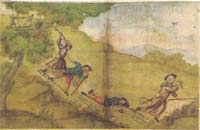 Into this complex network of Jacobean routes coming from all the corners of Europe are threaded those which begin in Portugal and these are as many as the actual opportunities for access from each locality to the Apostle’s tomb. However, out of all of them, the royal Oporto-Barcelos–Valença road has a particular importance, as here almost all the others come together, reinforcing this road as the backbone of the Portuguese Ways to Santiago.
Into this complex network of Jacobean routes coming from all the corners of Europe are threaded those which begin in Portugal and these are as many as the actual opportunities for access from each locality to the Apostle’s tomb. However, out of all of them, the royal Oporto-Barcelos–Valença road has a particular importance, as here almost all the others come together, reinforcing this road as the backbone of the Portuguese Ways to Santiago.
This was the route chosen by most of the Pilgrims going to Santiago, at least from the beginning of the 14th century. This is well evidenced in the numerous reports kept in the Compostela Archives and in the known references to its most distinguished Pilgrims: Santa Isabel, Queen of Portugal, Leon of Rotzmithal, Jerome Münzer, King Manuel, Confalonieri, Albani and probably also St. Francis of Assissi, Blessed Francisco Pacheco and many other eminent Pilgrims not chronicled. In effect, after the completion of the Barcelos Bridge in 1325 and the renovations to the one at Ponte de Lima at the same time, it was possible to follow a straight route without having to skirt around Braga and to cross dangerous rivers either by fording them or by boat. Rates, Barcelos, Ponte de Lima, Valença, Tuy, Redondela, Pontevedra and Caldas de Reis defined the new medieval route from Oporto to Santiago, having in common with the ancient Roman military via the odd urban stretch and the bridges, still used to span the more turbulent streams.
This road was also the one commonly used by the population which moved from South to North in the province of Entre-Douro e Minho, encouraged by its speed, safety and comfort. Along here went multitudes of the anonymous, vagrants, travellers, mule-drivers, peddlers, market-goers and local pilgrims. It was also used by the regular army, the Ordnance Company and common soldiers, by gangs of adventurers, bandits and smugglers. It was the scene of skirmishes, assaults and ambushes, it saw all sorts of people pass by and witnessed five centuries of tumultuous relations between two brother peoples Destiny did not wish to unite.

 Soult’s squadrons used it in 1809 and in the fratricidal conflict, which deeply marked the change of regime in the second quarter of the 19th century, it made its last contribution to the precarious communications system available at the time.
Soult’s squadrons used it in 1809 and in the fratricidal conflict, which deeply marked the change of regime in the second quarter of the 19th century, it made its last contribution to the precarious communications system available at the time.
It was the stability, which began to be established during the "Regeneration" that brought about the end of the old royal highway. The development of a new road network profoundly altered the status quo, and brought into being a drive towards modernisation, which could not accommodate the relics of an obsolete and archaic past, completely out of temper with the new ideology.
In this period and particularly in the province of Entre-Douro e Minho, Fontes Pereira de Melo’s modernisation policy acquired an extraordinary importance. At the beginning of the fifties (that is, in 1850), a new road was built to Viana, crossing the River Lima over a superb steel bridge and extending as far as Caminha and Valença. Another was built from Braga to Ponte de Lima, to the jubilation of the local population who, for a journey of six leagues, used to spend an unforgettable day going through narrow passes and marshes, sometimes jumping from log to log. At the same time, the Railway network was expanding, as far as Valença in 1882 and into Spain four years later.
Barcelos and Ponte de Lima ceased to be obligatory transit points on North-South journeys and Viana, already additionally titled " do Castelo", assumed hegemony as well as political and administrative leadership for the Alto Minho. In this new context, there was no justification for the creation of new alternatives, not even reinforcing or improving the old road, nominally the Ponte de Lima-Valença stretch, an undoubtedly difficult and onerous project, when Braga and Viana claimed priority from the Royal Munificence for access to the border.
For this reason, this road lost interest, it was abandoned and quickly forgotten, the old narrow passes cursed by William Kinsey, lying under dense brushwood and shrubs.
The manifest disinterest in the Barcelos-Ponte de Lima-Valença route, overtaken by more viable accesses to the border, ensured, all the same, a certain degree of preservation, given that other routes on which renovations were permitted retain little more today than a vague outline of the original road.
In the tranquillity of a landscape unspoilt by time, the road slowly disappeared under the muddy riverside pastures and the skeletal slopes of Labruja, where even the brushwood can not withstand erosion. However, the outline was there, reasonably well preserved, revealing itself here and there in a large stone cross, in shrines, in the remains of a causeway ingrained with deep ruts and almost always well recorded in the memory of the local people.
 Previous
Next Previous
Next 
|
